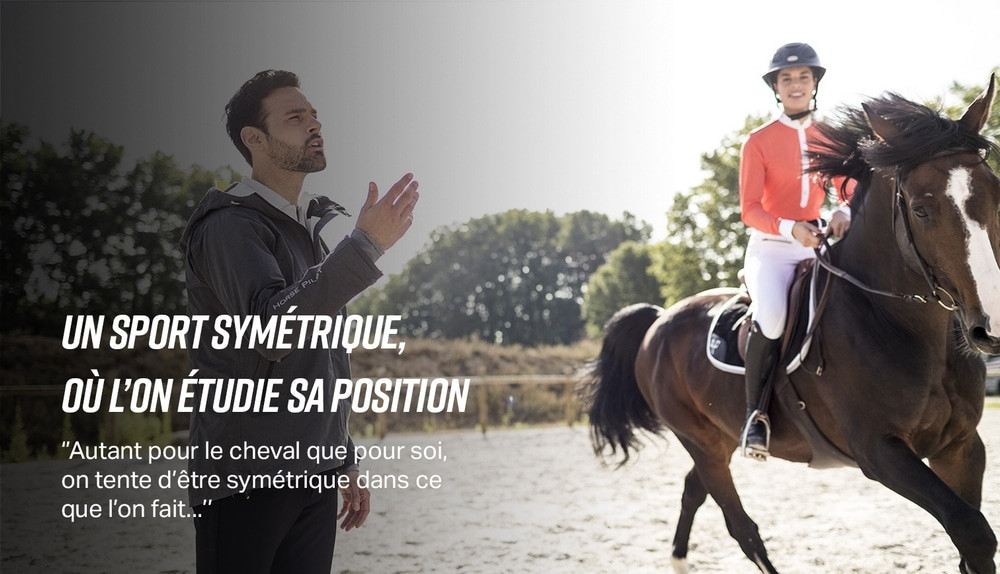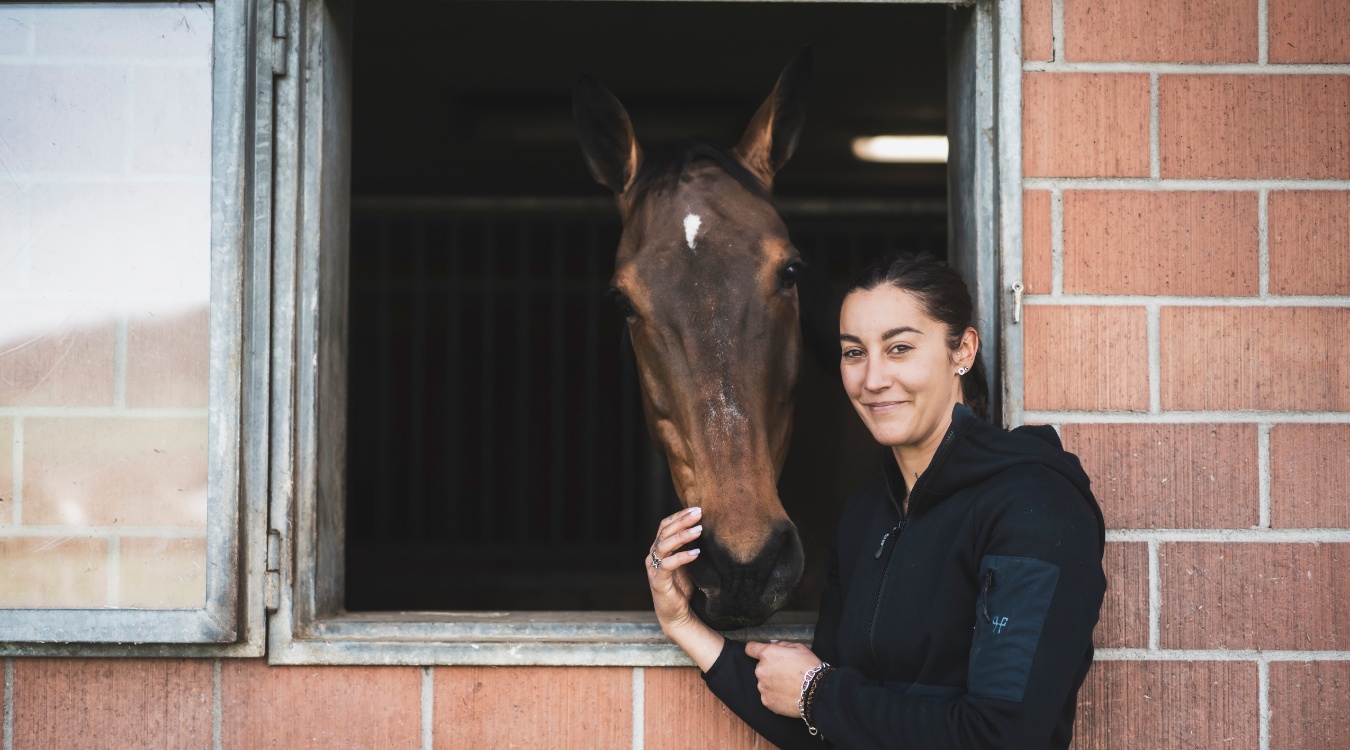
Meeting with a specialized health professional…
Vincent Rogine is a Mezierist physiotherapist:
A branch of the profession that specializes in muscle chains. She focuses on postural work to correct static disorders, learn to control her body well, by working on muscle chains. We had his contact thanks to our ambassador Félicie Bertrand and discovered that he was used to treating riders.
Located at the stables of Les Hauts Vents, in the heart of Normandy, it was naturally that athletes from the region came to him. From his experience and to be in contact with all types of riders, Vincent Rogine has his own idea on the question of riding and its impact on the body.
So riding: good or bad for health and back?
Horse Pilot: Which muscles and joints are most used in horseback riding?
Vincent Rogine: What is most stressed is the pelvis, and the ankle and knee joints, and the back… Muscle level is the abductors that cause problems and the retractions (shortening or reduction in volume of a tissue) of the posterior chains that are bothersome.
That is to say, if you have tensions in the calves and therefore the posterior chain, it can be a brake to have a correct position on horseback.
H.P. : And are there any pathologies that appear more frequently in riders? Does it depend on the disciplines?
Personally I know more about dressage and show jumping. The main problem we have is all tendonitis and tears of the abductors or muscles of the inner thigh, either for traumatic reasons or for chronic tensions that become painful.
In general patients with back pain are not aggravated by riding when they ride properly they are rather improved by riding.

One could say that the two good back sports are walking and horseback riding. What aggravates back problems are falls, and all the side effects; if you do the boxes, that you wear the bars… Spend your time leaning forward to pick up the feet, put on the studs…
H.P. You anticipated a little bit another question that concerned the side effects of riding. Working in a stable is a lot like holding a fork, a broom… With one hand at the top, one at the bottom, often always the same way!
V.R. Yes because when you are right-handed you are unable to hold the fork other than with the right hand at the top and the left hand at the bottom. We can’t do the opposite. So we twist our backs…
The interest of riding is that it is a symmetrical sport, where you study its position. In terms of body awareness, and the work of symmetry is interesting because we try to be symmetrical in what we do. Both for the horse and for either.
I never advise my patients not to ride. On the other hand, I say to them,”you go up with a protective vest, a bomb, at best an airbag but you protect yourself as much as possible because it’s when you fall that you’re not going to do yourself any good.”
H.P. : What advice would you have to give, simple and fast gestures to adopt to get in shape before the effort and to maintain your physical condition?
V.R. It is necessary to do a background work of placement and stretching of the body; it is not done 5 minutes. If you have something to do before going up it is to warm up the hips and abductors. It is really the muscle that is cold caught, you use the thighs suddenly it can cause tears so if there is one thing to do, it is to warm up the hips and abductors. There are not 36 of them!
H.P. : Could you describe these gestures?
V.R. Of course, when the rider is standing he puts his right heel, leg stretched, on a stool. He bends his left leg and puts his abductors under tension by lowering his center of gravity a little. His right leg remains taut by lifting the “flex” toes to pull on the back chain (back of the leg).
There is therefore no need for complicated equipment; a stool, a haystack… You can also work by slightly spreading both feet on the ground and gradually lowering your hips by spreading your legs.
You shouldn’t ride a horse while being all stiff and stuck, you have to warm up. In the best case, go to someone who will advise you and give you a daily program so that you can be warmed up three quarters of an hour before. The important thing is the preparation.

Another element to be well assimilated is the quality of muscle relaxation.
We are looking for the release of the horse: the rider must have the same one. We’re stiff because we’re tight in our heads. I treated a rider named Christian E. He’s very stiff. But when he climbs, we are unable to know because he climbs loose, it doesn’t bother him to climb. Relaxation is 50% physical and 50% mental. It really makes a difference.
H.P. How to find the right balance between relaxation and tonicity?
V.R.: The right balance is learning how to place your body. It doesn’t require strong muscle action. It is to be placed above your feet, to align your masses well; ankle, knee, pelvis, shoulders etc. as we are taught. The right distribution of the body and its centre of gravity is not on a muscular effort on the contrary.
You have to be able to do this by being as relaxed as possible and being just the right amount of muscle tension. You don’t ride horses to work out!
Be able to keep ease and fluidity in your body, without blocking anything. From the moment you block your body, it’s the horse that gets blocked and that’s it.
The key is mental control over your posture and muscles. Be able not to block your breathing. Yoga is good for that; there are many breathing exercises. Try not to have short, shallow breathing but rather in the stomach, regular and calm! Don’t stop breathing, take a deep breath, relax.
As long as breathing is blocked there is nothing you can do. It allows you to work on everything else afterwards.

H.P. I’m bouncing back on something you told me earlier, one of the best sports that complements riding was walking. Could you develop this idea?
V.R. Yes, simply. Walking with walking sticks (Nordic walking) is not traumatic, it works all the muscles, it works the breath! What may be missing for a rider; since the courses last 70 seconds (in CSO, ed.), we would have to find a more intense activity where we can train to make an effort for 1 minute and a half without being completely “roasted” after 45 seconds. So there you have to do either swimming – if it is well practiced – it can also be cycling by being able to hold the shock of an intense effort for 2 minutes… Training for short and intense efforts will be important. When you don’t have this training, you are in the dark at the end of your course or even your training session, because you are not breathing anymore. There is always a way to find a sport you like but have to do when you can (cycling, swimming, step…).


